More Heart Than Headcount? A Strategic Guide for Ambitious SMEs
What if growth wasn't about competition, but about connection? This guide introduces the Symbiotic Model of Influence, our core philosophy for ambitious SMEs. It’s a harmonious approach that shows how a clear Strategy, authentic Content, and a meaningful Presence work together to create lasting Influence. Hayarm Bildelar, a local family-run business. We show you the exact steps they took to apply this model and transform their brand, proving that you can out-think, out-care, and out-create larger competitors. Discover a more sustainable way to grow, where your audience members are the heroes of the story and your passion becomes your greatest advantage.
RESEARCHMARKETINGB2B MARKETINGBRAND STRATEGYSMI
Nour Fahed
9/24/202516 min read
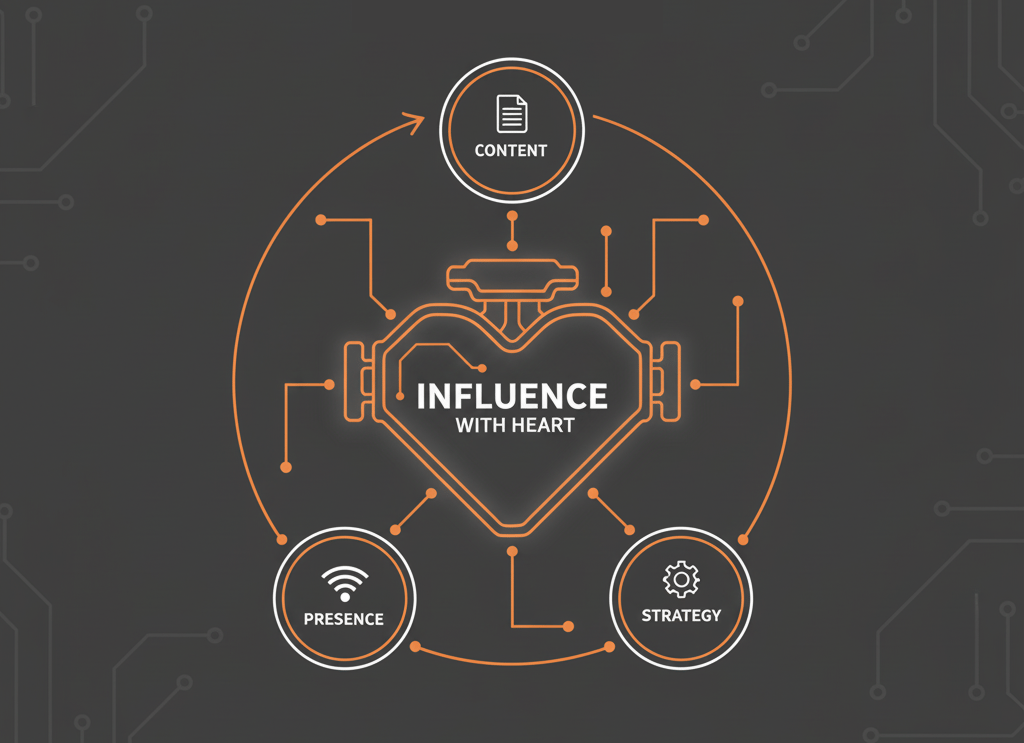

More Heart Than Headcount? A Strategic Guide for Ambitious SMEs
Introduction: The Swedish Underdog’s Unfair Advantage
If you are the owner of an ambitious small or medium-sized enterprise (SME) in Sweden, you know a reality that statistics cannot capture. It is the feeling of carrying an entire vision on your shoulders. It is the long hours fueled by a passion that larger corporations can only simulate in their marketing campaigns. And, most of all, it is the constant, nagging sense that you are outmatched, standing in the shadow of giants with seemingly infinite resources, their advertisements blanketing the landscape, their sheer scale a constant pressure.
This feeling is real, but the conclusion it suggests—that you cannot win—is not. This guide is built on a simple, powerful truth: You will never out-spend them. But you can out-think, out-care, and out-create them. When the authentic heart of your business is amplified by a smart, symbiotic strategy, your size becomes your greatest strength. Passion becomes your ultimate advantage.
This Guidebook, built upon the principles of our proprietary Symbiotic Model of Influence, is a roadmap for the journey ahead. It is a guide to transforming what feels like a disadvantage into a decisive edge. We believe strategy should be clear, not complex; it is about the discipline to focus on the few actions that deliver exponential impact.1 This guide is the antidote to the generic advice and tactical obsession that leaves so many ambitious companies feeling invisible.1 While this guide focuses on the practical application of our strategies, you can explore the complete theory behind our model on our website (The Symbiotic Model of Influence)
To prove that these ideas are not just theories, we will follow the true story of one such ambitious underdog. We will introduce you to Hayarm Bildelar, a family-run car parts shop in Eskilstuna. When they began their journey in 2022, they were the quintessential local hero: rich in passion and expertise, but lost in the modern marketplace. Their story began with a deep, gnawing frustration. Day after day, they felt invisible, their genuine expertise drowned out by the noise of their giant competitor, Mekonomen. They knew they were better, more knowledgeable, more passionate—but it felt like they were shouting into a void. Their growth was entirely dependent on the slow, unpredictable currents of word-of-mouth, leaving them feeling powerless against a corporate machine with a massive marketing budget and a network of over 14 brands.2
On paper, it was an impossible fight. But this is not a story of surrender. It is a hero's journey. Throughout this guide, we will walk step-by-step through Hayarm's transformation from a frustrated, invisible underdog to a recognized and indispensable local leader. We will show you how they used the very principles in these pages to forge an unshakeable strategy, build a trusted voice, and create a loyal ecosystem. Their story is proof that the right strategy is not about the size of your budget, but the depth of your thinking and the authenticity of your heart.
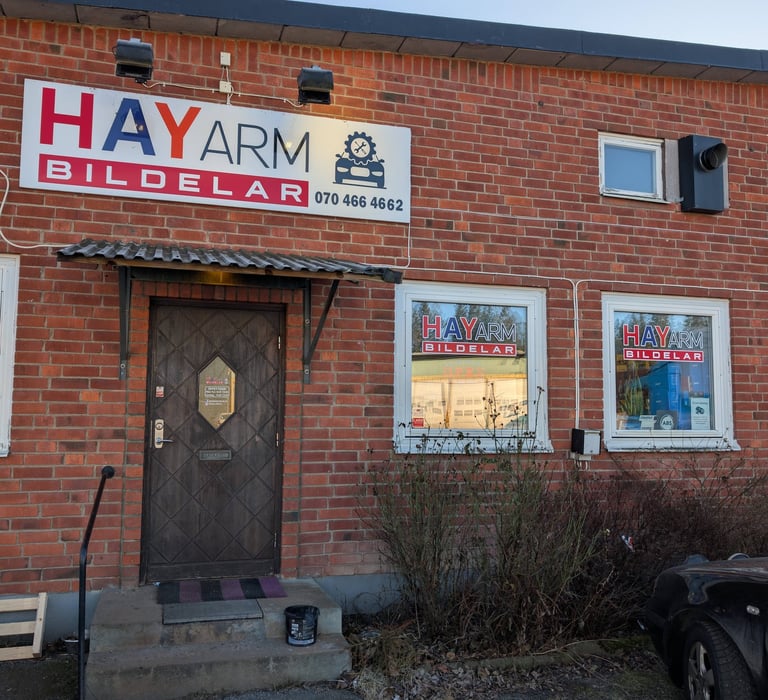

Hayarm Bildelar Store, Eskilstuna, Sweden
Photo taken by Nour Fahed
Before a single krona is spent on advertising, before a single social media post is written, the most critical work must be done. A house built on sand cannot withstand the slightest storm, and a business built on a fuzzy, unclear foundation will crumble under competitive pressure. This first part of our journey is about pouring the concrete. It is about achieving a profound and unshakeable clarity. This is the Strategy pillar of the Symbiotic Model in action: the blueprint for growth born from knowledge and empowerment. We will answer three fundamental questions that every ambitious business must face: Why do you truly exist? Who do you serve, and how is your offer a perfect match for their world? And finally, what is the story you are inviting them into—a story where they, not you, are the hero?
The Foundation: Forging Your Unshakeable Core (The Strategy Pillar)
Finding Your North Star: The Power of 'Why'
Imagine you are having a fika with a potential client. They take a sip of coffee and ask, "So, what is it you do?" The natural, almost reflexive, answer is to start with WHAT you do. "We sell car parts." "We are a marketing agency." It is logical, clear, and utterly forgettable. It is the answer that every one of your competitors gives. But what if you started differently? What if, instead of explaining what you do, you started by sharing WHY you do it?3
This is the simple, profound idea at the heart of what Simon Sinek calls The Golden Circle.4 He observed that the most inspiring leaders and organizations all think, act, and communicate from the inside out.6 They start with their "Why"—the purpose, cause, or belief that drives them.8 This approach is not just a communication trick; it is rooted in how our brains work. When you talk about your "What," you are speaking to the neocortex, the part of the brain that handles rational thought and facts. But when you share your "Why," you connect directly with the limbic brain, the powerful core that governs feelings, trust, loyalty, and decision-making.6 People do not buy what you do; they buy why you do it.
The Hayarm Bildelar Transformation: Part 1
Hayarm Bildelar's journey began in a place of deep frustration. Their message was a simple "What": "We sell car parts." This put them in a direct, hopeless fight with Mekonomen on the giant's chosen battlefield: price and selection. They felt like a commodity, their passion and expertise rendered invisible. Every day was a battle they were losing.
The turning point came not from a new marketing tactic, but from a simple conversation, much like that fika. They asked themselves the foundational question of the Golden Circle: Why did we start this business in the first place?10 The answer had nothing to do with inventory. It was about purpose. They rediscovered their "Why":
To empower independent mechanics and local car enthusiasts to keep their vehicles running safely and affordably, ensuring the spirit of Swedish car culture thrives.
This was their moment of transformation. They went from being a faceless seller of parts to the champion of a cause. This is the underdog's greatest advantage. A giant corporation's "Why" is often a slogan created in a boardroom to serve a campaign; its real purpose is shareholder value.3 But an SME's "Why" is almost always authentic, born from the founder's genuine passion.7 By rediscovering their purpose, Hayarm stopped fighting a battle they could not win and started a movement people wanted to join. They were no longer invisible; they had a soul.
The Perfect Match: Designing an Offer They Can't Refuse
Let's go back to that fika. You have shared your "Why," and your potential client is leaning in, intrigued. Now, imagine they start to vent about their problems. "The big suppliers are so impersonal," they might say, "and I can never get the expert advice I need." The temptation is to immediately jump in with your solution. But what if you just listened first? What if you made it your mission to understand their world—their frustrations, their hopes, their daily struggles—before you ever mentioned your product?
This is the essence of the Value Proposition Canvas (VPC). It is a tool that forces you to stop thinking about your own business and start by mapping your customer's reality.11 On one side, you create a Customer Profile. You do not list what you sell; you map their world. You identify their Jobs (the tasks they are trying to get done), their Pains (the frustrations and risks they face), and their Gains (the outcomes and benefits they dream of).13 Only after you have a deep, empathetic understanding of their world do you turn to the other side: the Value Map. Here, you design your Products and Services to be perfect Pain Relievers and Gain Creators that directly mirror what you learned about your customer.11
The Hayarm Bildelar Transformation: Part 2
Hayarm knew they could not win by being a smaller, weaker version of Mekonomen. Their path to victory was to stop trying to be everything to everyone and instead become the absolute best choice for a specific, high-value niche: the independent mechanic. This was their shift from feeling overwhelmed by the market to finding a defensible home within it.
Using the VPC, they built a deeply empathetic profile of "Erik," their ideal mechanic:
Telling Their Story, Not Yours!
Last fika, I promise. You have shared your purpose. You have listened deeply to their problems. Now, how do you talk about your solution? The biggest mistake most businesses make is casting themselves as the hero of the story. "We are the best! We are the most innovative!" But as Donald Miller, the creator of the StoryBrand Framework, explains, your customer is not looking for another hero. They are the hero of their own story, and they are looking for a guide.16
Think of any great movie. The hero is the one with the problem. They are lost until a wise character—a guide—enters the story, gives them a plan, and calls them to action. Your brand must be that guide.19 The StoryBrand Framework provides a 7-part structure that positions your business as the trusted mentor who helps the hero win.17 The guide must demonstrate two things:
Empathy ("I understand your struggle") and Authority ("I have the expertise to help you").17
The Hayarm Bildelar Transformation: Part 3
This was the final piece of the puzzle for Hayarm. It was the moment they went from feeling unheard to finding their powerful, confident voice. They stopped shouting about themselves and started telling their customer's story.
Here is Hayarm Bildelar's BrandScript:
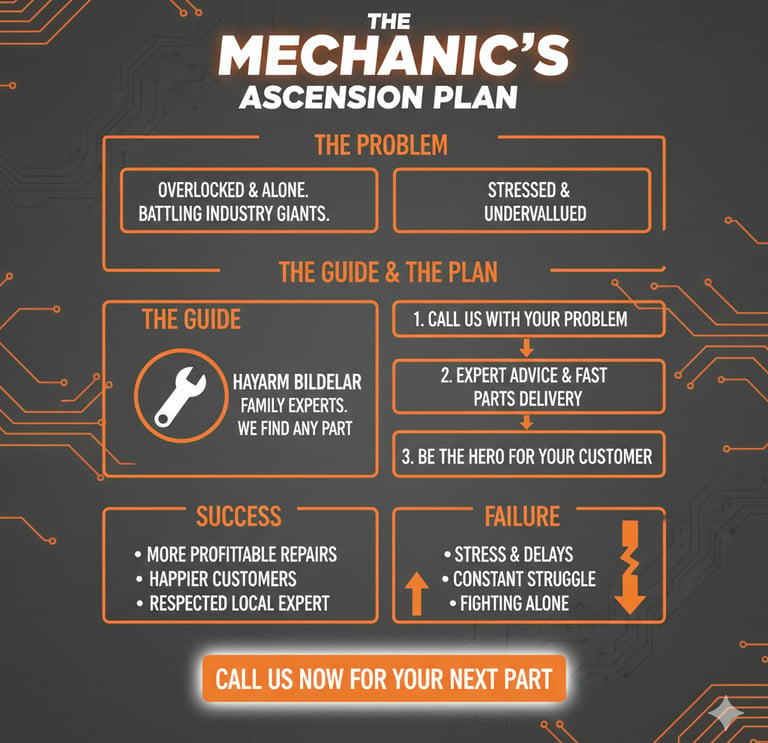

By positioning themselves as the guide, Hayarm transformed their customer relationships from transactional to relational. When the owner personally offers advice on a tricky repair, he is not a supplier; he is a mentor. This shift created a form of loyalty that was completely immune to the price-based attacks of their giant competitor. They had completed their initial transformation: from a frustrated underdog to a purposeful, empathetic, and trusted guide.
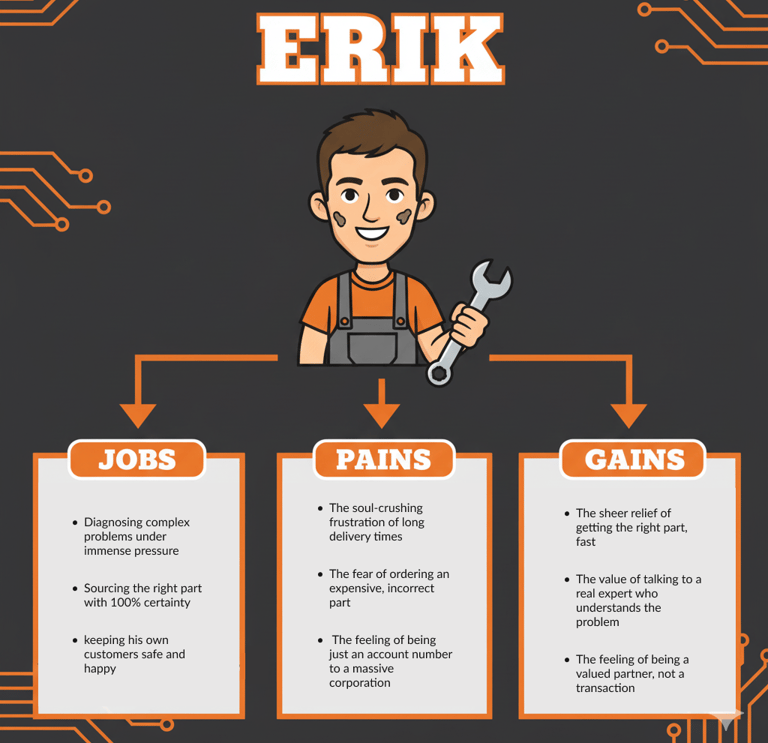

With this raw, emotional understanding, Hayarm designed a Value Map that was a perfect answer to Erik's anxieties:
Products & Services: A curated range of high-quality parts, specializing in the hard-to-find components that were Erik's biggest headache.
Pain Relievers: An "Expert Sourcing" promise, guaranteed same-day local delivery, and direct phone access to the owner for advice.
Gain Creators: A "Mechanic's Loyalty Program" and a "Right Part Guarantee" that completely eliminated his risk.
This exercise was Hayarm's strategic masterstroke. They used empathy as a weapon. The services they offered—like personal advice from the owner—were precisely the things that were impossible for a giant like Mekonomen to replicate at scale. They had found their niche, and in that niche, they were not just another option. They were the only logical choice.

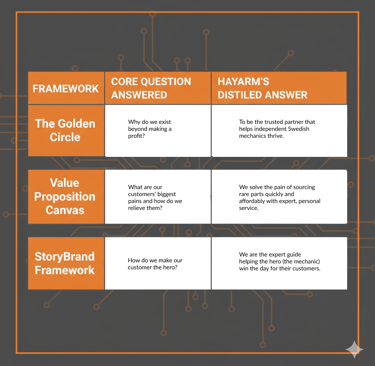
First Action: Part 1 Checklist
Clarity is not an accident; it is the result of focused work. Take the first step by scheduling three separate one-hour blocks in your calendar this week.
[ ] Action 1: The 'Why' Session. Answer the question: Beyond making money, what is our core purpose? What is the fundamental belief that drives our business? Write it down.
[ ] Action 2: The Customer Profile. Map out the Jobs, Pains, and Gains for your single most important customer type. Think about their world, not your product.
[ ] Action 3: The Hero's Story. Draft a simple, one-paragraph story for your business using the StoryBrand framework, ensuring your customer is the hero and you are the guide.
The Engine: Becoming Seen and Trusted (The Content Pillar)
With a clear and unshakeable strategic foundation, the next phase is to build the engine that will carry your message into the world. This is not about shouting the loudest or buying the most attention. For an ambitious SME, visibility and trust are not bought; they are earned. They are the natural result of being relentlessly helpful, consistently present, and strategically focused. This is the Content pillar of the Symbiotic Model in action: the tangible expression of your expertise, designed to build trust by consistently providing genuine value. In this section, we will explore how to multiply your impact without multiplying your workload and how to dominate your digital niche by being the most valuable voice in the room.
The Multiplier Effect: One Victory, Ten Stories
One of the greatest constraints for any SME is time. The idea of creating a constant stream of high-quality content for a blog, LinkedIn, email, and other channels can feel completely overwhelming. The solution is not to work harder, but to work smarter. This is the principle of content repurposing: the art of taking one significant, high-value piece of content and strategically transforming it into multiple different formats to be shared across various channels.23
This approach is a force multiplier for small businesses. It dramatically saves time and resources, allowing a small team to generate the output of a much larger one.26 It also significantly boosts your search engine optimization (SEO) by creating more unique, indexed assets around a core topic, increasing the surface area for potential customers to find you.27 Most importantly, it reinforces your core message through strategic repetition. When a potential customer encounters your core value proposition in different formats across different platforms, it builds familiarity and deepens trust.26
The Hayarm Bildelar Transformation: Part 4
Hayarm needed a way to translate their newfound strategic clarity into consistent visibility. Instead of trying to compete on platforms dominated by corporate budgets, they chose a channel that thrives on authenticity and community: Instagram. Their strategy wasn't about slick ads; it was about becoming the most helpful and welcoming voice in their local automotive scene.
Their feed became a hub of genuine knowledge. They shared practical tips about car technology, advice on maintaining a car's health, and the best ways to keep a vehicle in top condition. This knowledge-sharing was seamlessly attached to self-promotion. When they discussed the importance of quality components for a specific repair, they would naturally feature the high-quality parts they had in stock, positioning themselves as the expert source.
Crucially, their Instagram became a community hub. They announced collaborations with other local businesses and celebrated local car and sport-related events, weaving themselves into the fabric of the Eskilstuna community. This consistent engagement created a powerful "knot of referrals," as followers began to tag their friends and recommend Hayarm organically.
This digital presence was a direct reflection of their in-store experience. The heart of their branding, both online and off, was the message that Hayarm Bildelar is more than a store; it's a cozy home for car enthusiasts, a place where clients are always welcomed with a hot cup of coffee and a smile. Their Instagram feed felt like an extension of that warm, welcoming workshop, building a level of trust and community that no amount of corporate advertising could replicate.
First Action: Part 2 Checklist
Turn your strategy into visible action. This week, focus on creating your first pillar asset and identifying your digital territory.
[ ] Action 1: Identify Your 'Golden Story'. Think of your single best customer success story—the time you truly saved the day for a client. Write down the core details: the problem they faced, the solution you provided, and the amazing result.
[ ] Action 2: Brainstorm Five Repurposed Assets. Using your 'Golden Story' as the source, list five different pieces of content you could create from it (e.g., a short video testimonial, an infographic, a series of social media posts, etc.).
[ ] Action 3: List Ten Niche Keywords. Write down ten specific, long-tail search phrases that your ideal customer would type into Google when they have an urgent problem that you can solve. Think location, specific product names, and problem-based language.
The Ecosystem: Building a World They Won't Want to Leave (The Presence Pillar)
The final and most powerful stage in this journey is to transcend the cycle of constantly seeking new customers. It is about building a world around your existing customers that is so valuable, so supportive, and so integrated into their success that they would never dream of leaving. This is how you create a true, lasting Presence in your market—not just as a supplier, but as an indispensable partner. This is where the pillars of Strategy and Content converge and give rise to a thriving ecosystem. In this final section, we will explore how to map the path to loyalty, how to build powerful alliances, and how to light a campfire that turns a customer list into a loyal community.
The Path to Partnership – Mapping the Journey to Loyalty
To foster deep loyalty, you must first understand the journey your customer takes with you from their perspective. Many businesses think in terms of a "sales funnel," a model that is inherently company-centric, focused on pushing a prospect through stages. A far more powerful tool is the
B2B Customer Journey Map. This map is customer-centric; it chronicles the customer's actions, thoughts, and, most importantly, their emotions at every single touchpoint with your brand.

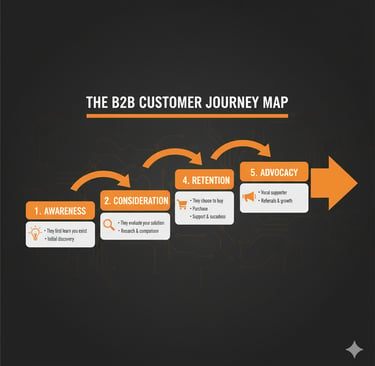
The purpose of mapping this journey is to identify the critical "moments of truth"—the key interactions where you have the opportunity to either build or erode trust.
The Hayarm Bildelar Transformation: Part 5
Hayarm's final evolution was from being a trusted guide to becoming an essential partner. This required them to map the emotional journey of their hero, "Erik the mechanic," and transform it from a series of transactions into a deepening relationship.
Awareness: Erik first hears about Hayarm from another mechanic or sees a helpful post on LinkedIn. His feeling: Curious, but skeptical.
Consideration: He decides to "test out" Hayarm with a non-urgent part. His feeling: Hopeful, but cautious. The owner himself answers the phone, providing confident, friendly advice. This personal touch shatters his expectation of a typical supplier.
Decision: The part arrives on time, correct, and fairly priced. Tucked inside the box is a handwritten thank you note. His feeling: Relieved, and pleasantly surprised.
Retention: An urgent, high-stakes repair comes in. A customer's car is off the road. Erik's first and only call is to Hayarm. His feeling: Confident, trusting. The owner goes above and beyond, delivering the part personally after hours. This is the moment the relationship is sealed.
Advocacy: Erik is now a loyalist. He actively recommends Hayarm to other garage owners. His feeling: Loyal, part of a tribe.
This map reveals the SME's most potent secret weapon: the human touch. Large corporations use journey mapping to automate and increase efficiency. An SME can use the same map to identify the moments where a personal,
Stronger Together: The Power of Symbiotic Alliances
No business is an island. Your customers have needs that extend beyond your specific product or service. A powerful way to deepen your value and create a defensive "moat" around your business is to form strategic partnerships. These are collaborations with non-competing businesses that serve the same customer base, allowing you to pool resources, share audiences, and achieve mutual success.
For an SME, the benefits are immense. Partnerships provide immediate access to new, highly qualified customers, allow you to share marketing costs, and enable you to offer a more holistic solution. The key is a deep alignment of values, clear and mutually beneficial goals, and open, consistent communication.
Creating a Community, Not Just a Customer List
The final, and perhaps most profound, step in building an unassailable presence is to foster a genuine community. A brand community is not an audience you broadcast to; it is a space you facilitate, where customers can connect with each other and with your brand around a shared identity, passion, or purpose.
In a thriving community, the brand steps back from being the star of the show and becomes the host of the party. The focus shifts from selling to serving, providing value through four key pillars: Content (exclusive resources), Conversation (sparking meaningful discussions), Connection (helping members build relationships), and Co-creation (involving members in the brand's future). The goal is to cultivate a powerful sense of belonging.
The Hayarm Bildelar Transformation: Part 5
This was the final stage of Hayarm's hero's journey: the moment the underdog became the leader. They recognized that independent mechanics often work in isolation, craving a peer network. Hayarm decided to build that network.


This community became Hayarm's ultimate competitive moat. A giant like Mekonomen can copy a product or match a price. What they cannot replicate is a genuine sense of belonging. The relationship was no longer transactional; it was cultural and emotional. For a mechanic to leave Hayarm now would mean leaving their professional support system, their peer group, their campfire. This is the ultimate expression of the "More Heart Than Headcount" philosophy. The once-invisible underdog had built a loyal tribe, an unassailable advantage born not of budget, but of a deep and authentic commitment to the success of others.
First Action: Part 3 Checklist
Build an ecosystem that lasts. This week, lay the groundwork for a deeper, more resilient relationship with your customers.
[ ] Action 1: Map the Journey. On a simple piece of paper, draw the five key stages of your customer's journey (Awareness, Consideration, Decision, Retention, Advocacy). Under each stage, write down one small, personal action you could take to make that experience better.
[ ] Action 2: Identify Three Potential Partners. List three non-competing businesses whose services your ideal customer also uses. Think about who you could collaborate with for mutual benefit.
[ ] Action 3: Define Your Community's Purpose. If you were to create a "campfire" for your customers, what would its core purpose be? What shared interest or challenge would bring them together? Write down a single sentence that defines this purpose.
Conclusion: Your Turn to Lead
Throughout this guide, we have followed the journey of Hayarm Bildelar. We watched them transform from a passionate but frustrated underdog, feeling invisible and outmatched, into the strategic, respected, and deeply connected leader of their niche. Their victory was not won by matching the budget of their giant competitor. They won by being smarter, more empathetic, and more committed to the success of their customers.
Their hero's journey began by forging an unshakeable foundation of clarity—rediscovering their "Why," designing a perfectly matched value proposition, and learning to cast their customer as the hero of the story. They built an engine of visibility and trust, not by shouting, but by being relentlessly helpful, turning a single victory into a chorus of social proof. And finally, they built a thriving ecosystem—a network of partners and a loyal community—that transformed their business from a simple supplier into an indispensable hub.
Their story is a testament to the core thesis of this manifesto. The strategies of purpose, empathy, storytelling, and community are not luxuries reserved for those with large marketing departments. They are, in fact, the unique and powerful weapons of the ambitious SME. The giants may have the headcount, the bureaucracy, and the massive budgets. But you have the heart, the agility, and the authentic passion of a founder. Now, you also have the strategy. It is your turn to lead.

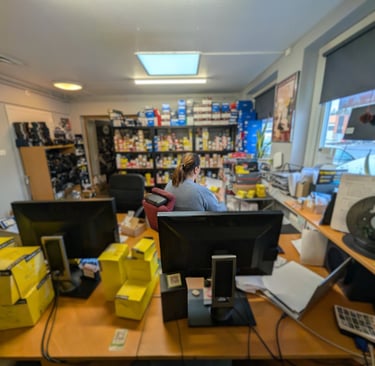
This is just the beginning of a lifetime journey...
Hayarm Bildelar Store, Eskilstuna, Sweden
Photo taken by Nour Fahed
